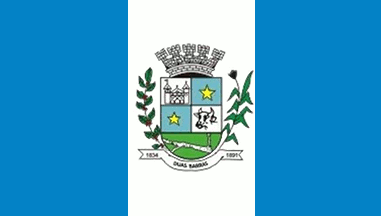 image located by Dirk Schönberger,
14 October 2011
image located by Dirk Schönberger,
14 October 2011Source: http://cid-57cc02038c003794.office.live.com/self.aspx/.Documents

Last modified: 2012-03-26 by ian macdonald
Keywords: rio de janeiro | duas barras |
Links: FOTW homepage |
search |
disclaimer and copyright |
write us |
mirrors
 image located by Dirk Schönberger,
14 October 2011
image located by Dirk Schönberger,
14 October 2011
Source:
http://cid-57cc02038c003794.office.live.com/self.aspx/.Documents
Official website at
http://www.duasbarras.rj.gov.br.
Dirk Schönberger, 14
October 2011
The municipality of Duas Barras (10,933 inhabitants in 2010; 375 sq. km) is located in central Rio de Janeiro State, 180 km of Rio de Janeiro. Duas Barras originates in the Tapera Estate, which developed near a chapel built in 1834 by the Brotherhood on Our Lady of the Conception on a plot of land offered by Father Francisco José de Oliveira. The commune of Nossa Senhora da Conceição de Duas Barras do Rio Negro was established by Provincial Law No. 92 of 24 October 1856. The municipality of Duas Barras was established by Provincial Law No. 233 of 8 May 1891, seceding from Cantagalo. The main famous child of Duas Barras is the singer Martinho José Ferreira (b. 1934), better known as Martinho da Vila (for its affiliation samba school Vila Isabel).
The coat of arms of Duas Barras is "Quarterly, 1. Argent a church of
the same masoned sable, 2. Azure a star or, 3. Azure three stars or
per bend sinister, 4. Argent a bovine's head of the same outlined
sable, in base vert two river confluences of the first". The shield
surmounted by a five-towered mural crown argent. The shield flanked
dexter by a branch of coffee fructed proper and sinister by a plant of
maize fructed proper. Below the shield a scroll argent outlined sable
inscribed in letters sable "1834 - DUAS BARRAS - 1891".
The church represents the religious faith. The big star represents the
town of Duas Barras proper, the seat of the municipality. The three
smaller stars represent the districts of Monnerat, Fazenda do Campo
and Vargem Grande. The bovine represents cattle breeding,a min source
of income in the region. The base represents the confluence of river
Rezende with the Black river and Córrego do Baú, the namesake of the
municipality (lit. "Two confluences").
The mural crown stands for a "cidade".
The coffee branch recalls that the municipality was once of the main
coffee producers in the Rio de Janeiro State. It is also a main
exporter of maize.
http://www.duasbarras.com/rj/index.php?option=com_content&view=article&id=154&Itemid=129 - Municipal website
Ivan Sache, 12 March 2012